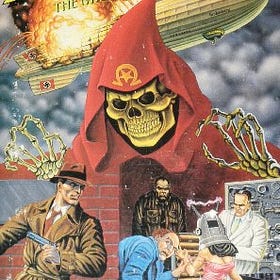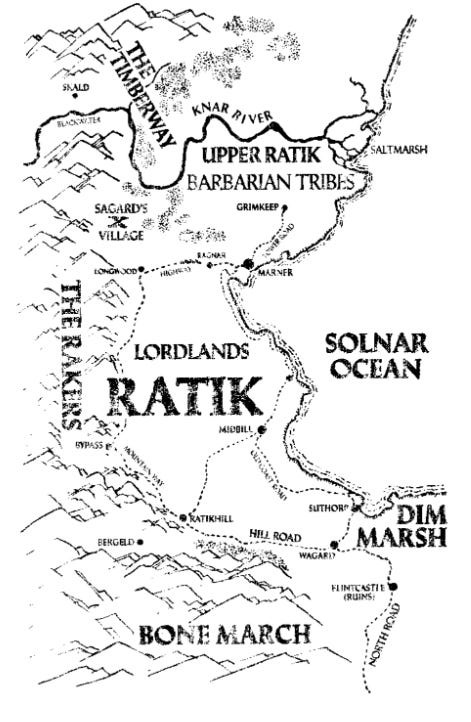Adventure Gamebooks as RPGs -- Sagard the Barbarian: #1 The Ice Dragon
Do Gamebooks Provide Enough Rules for a Full RPG?
Barbarians at the Gates
Back in May of 2023 J.Q. Graziano wrote a post about Flint Dille and Gary Gygax’s Sagard the Barbarian series of fantasy gamebooks. I came across the article today when J.Q. shared the item on his Facebook page and since I’d missed the article the first time around, I hopped right on over and read it. It’s a fairly good review of the book and series and highlights an often overlooked Gamebook series. It’s a shame that the series is overlooked because not only do they feature excellent Richard Corben covers, they were written by Gary Gygax and Flint Dille.
I interviewed Dille and David Marconi regarding their Agent 13 character back in 2013 and during that conversation there were a couple of asides that mentioned Dille’s relationship with Gygax, including a mention of the Sagard books series.
Episode 135 -- Discussing Agent 13 with Flint Dille and David Marconi (July 10, 2013)
Back in 2013, my good friend and former Geekerati Co-host, Bill Cunningham published Flint Dille and David Marconi’s Agent 13 novels through his Pulp 2.0 publishing house. The novels were originally …
It seems natural Gary Gygax, the co-creator of the Dungeons & Dragons role playing game, would dive into the adventure gamebook craze and he did so in 1985 with the Sagard the Barbarian series of gamebooks. Players of Dungeons & Dragons might notice where the books are set because this series of four interactive novels took place in Gary Gygax's signature World of Greyhawk campaign setting.
Sagard's adventures in The Ice Dragon begin in a mountain range called The Rakers which make up the border of Ratik and the Theocracy of the Pale. Because Sagard’s adventures are set in the World of Greyhawk, there’s a ton of published setting material a GM can use, even if they chose to use the gamebook mechanics instead of D&D.
Gygax co-wrote the Sagard series with Flint Dille. Dille's other works have included the Transformers and GI Joe TV series, as well The Chronicles of Riddick: Escape from Butcher Bay video game. Gygax met Dille while he was in Hollywood working on the Dungeons & Dragons animated series, and his relationship with Dille led to Gygax asking Dille's sister Lorraine Williams to help save a floundering TSR in 1984. The Williams saga is its own story, one which has left Lorraine's name an epithet in some gaming circles. That story is ably covered by Ben Riggs in his book Slaying the Dragon.
Needless to say, by the end of 1985, the same year that The Ice Dragon was published, Gygax sold his stock in TSR to Williams and ended his relationship with the company.
All of this leaves one to wonder what Gygax thought of Dille and whether the Williams affair is one of the reasons why the Sagard saga is limited to the four existing volumes. Based on the interview I had with Dille, I think their relationship remained strong as Dille describes the years he got to hang out with Gygax as some of the best years of his life.
The Ice Dragon is an engaging gamebook, but is its game system sufficient to support game play outside of the game book environment?
Let's have a look at the rules.
Game Mechanics
With the exception of rules for keeping track of "trophies" that Sagard collects during his adventures,The Ice Dragon rules set is entirely limited to combat mechanics. By itself, this doesn't automatically mean that the rules won't be able to be expanded into a complete rpg, combat is a central part of most rpgs, but it does mean that there will be some work for the game master who tries to adapt the system. If the combat system is robust enough, than one could extrapolate from those rules to create mechanics for other actions as well. Games like Dragon Age use the same mechanics for combat resolution and task resolution, so it can be done.
The Ice Dragon's combat mechanics are relatively simple. Characters and opponents are rated for Hit Points which determine how much damage an individual can take before being defeated. These are a common mechanic in D&D descended rpgs. Characters and opponents are also rated by level which represents their skill in combat. Their effectiveness in combat is determined by rolling a 4-sided die and comparing the result to the character's statistic block. An example of a character's statistic block looks something like the following:
This stat block tells us that Sagard is level 2, has twenty hit points, and how much damage he does depending on the roll he makes on a 4-sided die. For example, if Sagard rolled a 3 on the die he would do 1 point of damage. Given that each number has an equal chance of occurring, this gives Sagard an Average Damage per Round of:
DPR = (.25)(0) + (.25)(1) + (.25)(1) + (.25)(2) = 1
A level two character like Sagard delivers 1 point of damage per round to his opponents, so it would take Sagard approximately 20 rounds to defeat someone as tough as himself. Thankfully, most monsters don't have the same number of hit points as Sagard or game play would be quite time consuming. The high threshold of hit points were potentially necessary in order to enable a reader to get Sagard through the book’s narrative alive, but they might be excessive for a table top rpg.
The full chart for combat effectiveness can be seen in the table below:
Looking at this table, I can see one quick discrepancy. Level 0 characters have the same average DPR as Level 2 characters, and are more effective than Level 1 characters on average, but only succeed 25% of the time. I understand that the mechanics are attempting to represent Level 0 characters as "unpredictable" and capable of "getting lucky" but the results don't seem quite satisfying. I might change the “damage” on a 4 for Level 0 characters to 2. That keeps the average the same as Level 1 characters over time, but makes them less consistent.
These mechanics are easy to understand and present a fairly limited combat system. The system doesn't compare the combat abilities of combatants, like Fighting Fantasy, nor does it offer the possibility of maneuvers like Fighting Fantasy does with its "luck" mechanic.
This system could be used as a basis for a skill system. Players could receive level ratings in skills. For example, Sagard might have a Level 2 skill in Stealth. This would allow him to roll 1 or 2 "skill success points," on a roll of 2 or better, demonstrating how stealthy the character was. These points could be compared to an opponent's Perception skill. If the opponent generates more skill success points than Sagard, then Sagard fails to hide.
Hmm...I actually like that. In this case, a Sagard stat block might look like the following:
SAGARD
Combat (Level 2: 1/0, 2/1, 3/1, 4/2)
Stealth (Level 2:1/0, 2/1, 3/1, 4/2)
Perception (Level 1: 1/0, 2/0, 3/1, 4/1)
[20][19][18]...[3][2][1]
The Ice Dragon, unlike the Fighting Fantasy Gamebooks, does provide a simple system for character advancement. As a character wins and loses combats he acquires and loses "experience marks." When Sagard has acquired enough experience marks, he acquires the abilities of the next level. One could easily expand the experience mark system to the skills system by giving 1 mark per successful use of the skill, or even failures if the attempted use was creative enough.
As you can see, the system in The Ice Dragon taken by itself doesn't provide a full game system, but that it can fairly easily be expanded to create one. Were I to use the "Sagard System" as the basis for a game though, one of the first things I would change is the use of the 4-sided die for resolution determination. There isn't enough variety in it and when comparing the different levels it allows for a Level 0 individual to be as good as a Level 2 character on average.
I do like the idea of a flat distribution, rather than a curved distribution like in Powered by the Apocalypse games, because it allows for either a consistent static bonus (say +1 to +4) or an advantage/disadvantage system to be used without disrupting the mechanics too much.
What do you say? Do you want to develop a single page RPG using the “Sagard System”? If so, what die should we use as our foundation?








Great article about the Sagard gamebooks and toying with their mechanics, Christian! I didn't know you interviewed Flint Dille, so have a tab open with it to listen later. When I wrote my newsletter, I got some good insight into these books and the D&D (and Saturday-morning cartoon) world at that time by reading Flint's book: "The Gamesmaster: My Life in the '80s Geek Culture Trenches with G.I. Joe, Dungeons & Dragons, and The Transformers".